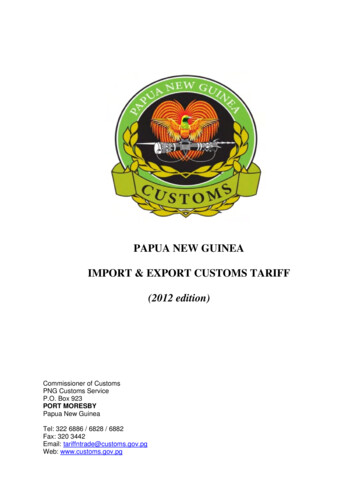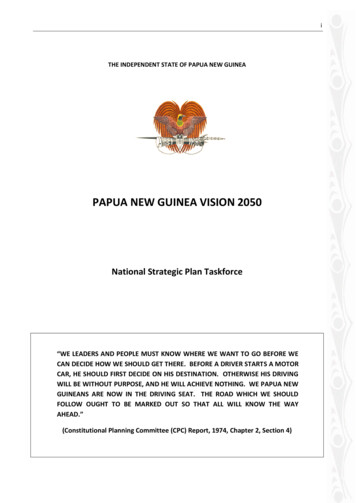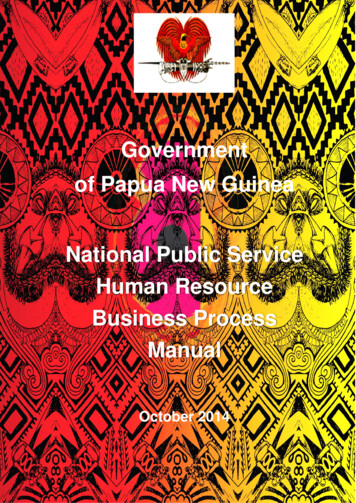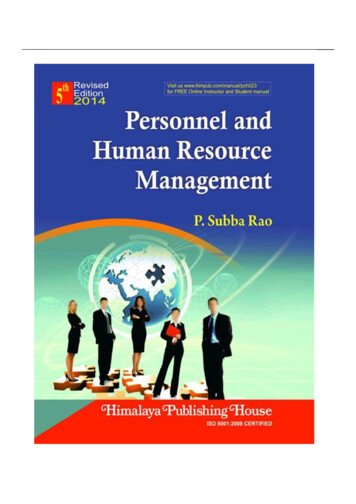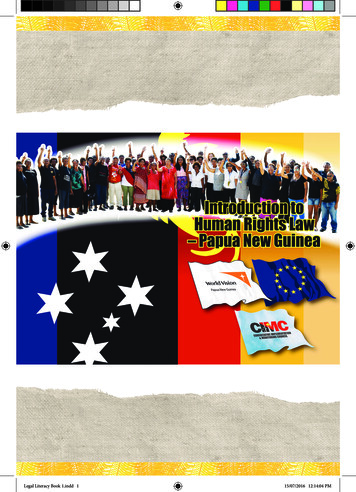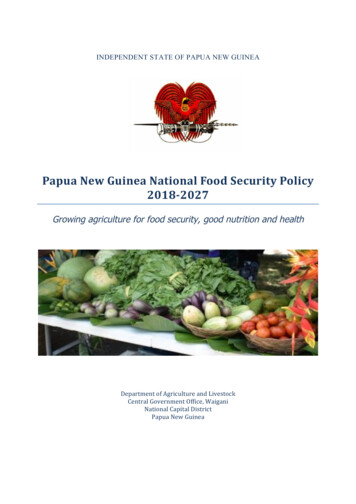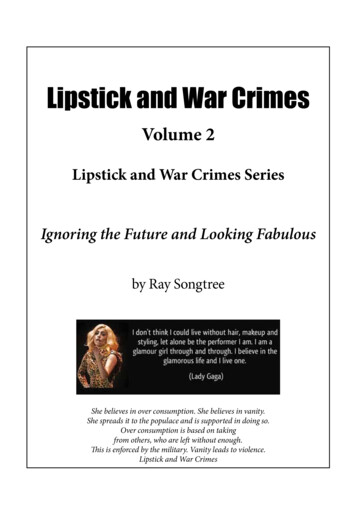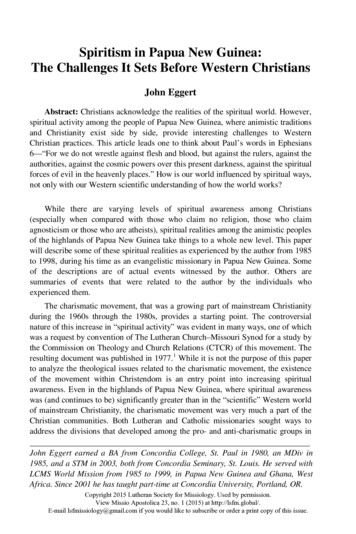
Transcription
Spiritism in Papua New Guinea:The Challenges It Sets Before Western ChristiansJohn EggertAbstract: Christians acknowledge the realities of the spiritual world. However,spiritual activity among the people of Papua New Guinea, where animistic traditionsand Christianity exist side by side, provide interesting challenges to WesternChristian practices. This article leads one to think about Paul’s words in Ephesians6—“For we do not wrestle against flesh and blood, but against the rulers, against theauthorities, against the cosmic powers over this present darkness, against the spiritualforces of evil in the heavenly places.” How is our world influenced by spiritual ways,not only with our Western scientific understanding of how the world works?While there are varying levels of spiritual awareness among Christians(especially when compared with those who claim no religion, those who claimagnosticism or those who are atheists), spiritual realities among the animistic peoplesof the highlands of Papua New Guinea take things to a whole new level. This paperwill describe some of these spiritual realities as experienced by the author from 1985to 1998, during his time as an evangelistic missionary in Papua New Guinea. Someof the descriptions are of actual events witnessed by the author. Others aresummaries of events that were related to the author by the individuals whoexperienced them.The charismatic movement, that was a growing part of mainstream Christianityduring the 1960s through the 1980s, provides a starting point. The controversialnature of this increase in “spiritual activity” was evident in many ways, one of whichwas a request by convention of The Lutheran Church–Missouri Synod for a study bythe Commission on Theology and Church Relations (CTCR) of this movement. Theresulting document was published in 1977.1 While it is not the purpose of this paperto analyze the theological issues related to the charismatic movement, the existenceof the movement within Christendom is an entry point into increasing spiritualawareness. Even in the highlands of Papua New Guinea, where spiritual awarenesswas (and continues to be) significantly greater than in the “scientific” Western worldof mainstream Christianity, the charismatic movement was very much a part of theChristian communities. Both Lutheran and Catholic missionaries sought ways toaddress the divisions that developed among the pro- and anti-charismatic groups inJohn Eggert earned a BA from Concordia College, St. Paul in 1980, an MDiv in1985, and a STM in 2003, both from Concordia Seminary, St. Louis. He served withLCMS World Mission from 1985 to 1999, in Papua New Guinea and Ghana, WestAfrica. Since 2001 he has taught part-time at Concordia University, Portland, OR.Copyright 2015 Lutheran Society for Missiology. Used by permission.View Missio Apostolica 23, no. 1 (2015) at http://lsfm.global/.E-mail lsfmissiology@gmail.com if you would like to subscribe or order a print copy of this issue.
Spiritism in Papua New Guinea 57the church.As an evangelistic missionary, I was called on several times to lead Bible studiesin different locations of the Gutnius Lutheran Church in an effort to shed light on theissues at hand. One of the most common manifestations of the “spirit movement”was an activity called “bung prayer,” or group prayer. In areas where it was part ofthe local Christian “culture” there was often a time during the worship service whenthe leader provided an opportunity for all to speak their own prayers out loud. Someof the people prayed in the local language. Others spoke in ways that wereunintelligible to those around them, which was seen as speaking in tongues as led bythe Holy Spirit.Often division arose among Christians, some arguing that if you didn’tparticipate in “bung prayer” you were not a real Christian, while others argued that“the missionaries didn’t teach us in this way and it wasn’t right.” The Bible studiesmost often focused on portions of Scripture that emphasize the unity of the Body ofChrist, the possibility of specific spiritual gifts (including speaking in tongues) thatwere meant for the building up of the Body of Christ, not dividing it, and theimportance of acknowledging that the presence or absence of a specific spiritual giftdoes not determine whether or not one is a Christian. Needless to say, these issueswere not quickly resolved and likely still provide challenges among the Christians ofPapua New Guinea. The example of “bung prayer” is only one of the issuesconnected to the spirit movement, but it is one that provides a bridge from ourWestern Christian way of thinking to that of the thinking process of the Christians ofPapua New Guinea. What follows here takes us more deeply into a spiritual worldthat is significantly different from that of our Western worldview.Dealing with spiritual activity was often very much a part of the thinkingprocess of the Enga people, among whom we lived. Timothy Lutheran Seminary waslocated on an eight-acre parcel of land along the main road. People lived on smallplots of land handed down in the tribal community. Kutasi was one of the locallandowners whose ancestors had agreed to lease land to the seminary. He was ayoung man with a family. From time to time, he would work at the seminary—mowing the lawn, doing basic construction projects, and other things as needs arose.One day, he came to my door looking very sick. He said, “John, I’m sick. I need togo to the hospital.” He knew I had a vehicle and wouldn’t charge him if I took him. Ididn’t really want to go, nor did I want him to die because I didn’t help. We got intothe pickup and drove the half an hour to the hospital to which he wanted to go. Idropped him off at the hospital and returned home.About a week later, Kutasi was again around the seminary community. He stillwasn’t well but was somewhat functional. A few days later, he was on my doorstep,looking even worse than the first time. He wanted to return to the hospital, but Isimply didn’t have time to take him. Instead I gave him the equivalent of five dollarsto pay for a public motor vehicle so that he could go on his own.Copyright 2015 Lutheran Society for Missiology. Used by permission.View Missio Apostolica 23, no. 1 (2015) at http://lsfm.global/.E-mail lsfmissiology@gmail.com if you would like to subscribe or order a print copy of this issue.
58 Missio ApostolicaTwo days later, word came that Kutasi had died at the hospital. Kutasi’s tribe(close family) determined that a man named Raymond had “worked magic” thatcaused Kutasi’s death. As an outsider, I was not privy to the decision-makingprocess. What I did know was that Raymond was from a coastal area that was knownfor its use of magic, that is, using spiritual forces to affect the lives of people. Helived near Timothy Lutheran Seminary in a small village setting with some othernon-Enga people, some of whom worked at a local community school and others(including Raymond) who worked for the Enga Provincial Government. He workedfor the department of public works and was licensed to do blasting work in roadconstruction. He, along with several others in his community, were members of theBetamanda Congregation that met every Sunday in the Timothy Lutheran Seminarychapel. Kutasi and his family also attended that service regularly.As soon as Raymond was accused of using spiritual powers to cause Kutasi’sdeath he was “gone” from the community. Had he not left, he would likely have beenkilled in retaliation. In the following days and weeks, negotiations went on betweenKutasi’s tribe and Raymond’s community as to what the appropriate compensationwas for Kutasi’s death. Only when Raymond’s community had paid the agreed uponnumber of pigs and amount of money in the local currency (Kina) was Raymondable to safely return to the community.While I was not involved in any of the conversations associated with thesituation, local pastors who were teachers at Timothy Seminary were involved. Theywere experienced in the application of Law and Gospel from the Lutheran Christianperspective and also fully aware of the cultural factors relating to spiritualunderstandings of the events. My Western worldview says: “How did they provethis? What evidence did they present?” At the same time, my mind goes to Paul’sstatement to the Ephesians:Finally, be strong in the Lord and in the strength of his might. Put on thewhole armor of God, that you may be able to stand against the schemes ofthe devil. For we do not wrestle against flesh and blood, but against therulers, against the authorities, against the cosmic powers over this presentdarkness, against the spiritual forces of evil in the heavenly places. (Eph6:10–12 ESV)We find various ways to apply that statement to issues in our Western way ofthinking, but it seems to connect rather directly to an understanding of the use ofspiritual powers in the death of Kutasi.Another example of attributing the actions of an individual to spiritual powersinvolved a woman, Andasowame, who helped my wife Jeanette with washing clothesand garden work when we lived at Yaramanda, the first Lutheran mission station inthe Enga Province. Her son was attending high school and was accused of raping oneof the high school girls. One day she arrived on our doorstep in tears. When JeanetteCopyright 2015 Lutheran Society for Missiology. Used by permission.View Missio Apostolica 23, no. 1 (2015) at http://lsfm.global/.E-mail lsfmissiology@gmail.com if you would like to subscribe or order a print copy of this issue.
Spiritism in Papua New Guinea 59finally got the complete story, the situation had taken a spiritual twist. The localleaders, including one of the old evangelists/pastors who had been trained by Rev.Otto Hinze, the first missionary, had come to Andasowame and explained that thereason her son was in trouble was her own fault. According to their understanding,she had not properly cared for her dying father-in-law and now the spirit of that deadman was repaying her by causing her son to engage in this inappropriate activity.My initial response was: “How in the world could they even think of this?”However, as a new missionary, I was in no position to challenge them. The situationwas in the hands of several local church leaders and they had to handle it in the waythat fit with their culture and Christian theological understanding.Unfortunately, we never did learn the outcome of the whole situation. Did sheaccept that it was her “fault?” What was the “proof” of this spiritual activity?However, we do know that this event did not destroy her Christian faith. AlthoughAndasowame did not have the title “deaconess,” she was in actuality a deaconess.One evening, just as the sun had set and the evening rain had settled in, she came toour door with her kerosene lantern in hand to tell us about something that hadhappened that day. When we asked where she was going she replied, “To Biblestudy. One’s faith can’t be strong if one only worships one day a week.” With that,she set off in the dark, in the steadily falling rain, with her lantern to attend anevening Bible study. While she dealt with some spiritual realities that were quitestrange from our perspective, her Christian faith shone through in ways that we couldonly hope many American Christians would emulate.From time to time, former missionaries would return to Papua New Guinea tovisit the areas in which they had worked and see some of the local people with whomthey had worked. One such visitor, Pastor Gary Teske, had spent several years in afairly remote location and was well-known for having been fluent in the Engalanguage.One evening, before dinner, we were standing outside, talking with a pastorfrom another remote area, Pastor John Hulip, when Teske recalled an event inHulip’s area. Pastors Marcus Felde and Teske were on a patrol into a rather remotearea, and Hulip was with them. They came to one location and found the communityin an unsettled state. After some inquiry, they learned that a local woman was dying.Being concerned for the woman’s welfare, they sought to have the woman brought toan open area for further evaluation and possible evacuation. The people were quitehesitant and resistant. After some time, and some rather persuasive arguments on thepart of the missionaries, the people agreed and the woman was carried to a clearing.The missionaries examined her and found that she had a broken leg. Having accessto a radio, they arranged for a helicopter to come in and evacuate the woman and herinfant child for medical care.Copyright 2015 Lutheran Society for Missiology. Used by permission.View Missio Apostolica 23, no. 1 (2015) at http://lsfm.global/.E-mail lsfmissiology@gmail.com if you would like to subscribe or order a print copy of this issue.
60 Missio ApostolicaAfter the evacuation, more discussion took place, and the missionaries learnedthe rest of the story. The woman had not had an accident. In fact, the local peoplesuspected her of being a witch and were actually killing her when the missionariesarrived on the scene. Had they not arrived, the woman (and her son) would havedied. Needless to say, the missionaries had various reactions, including relief athaving saved the woman, but also concern as to whether or not they were in dangerof some form of retribution for having interrupted the carrying out of a form of“justice” that had been decreed by the local community. Needless to say, the fact thatTeske was standing there telling the story was proof that they had not suffered anynegative consequences over the incident.Having completed the story, Teske turned to Hulip and said, “Whateverhappened to that woman?” Hulip replied, “She and her son returned to the area andshe is still alive today.” He then turned to me saying, “Do you remember Nason? Heis the little boy who was evacuated with her.”Nason had been a student at Timothy Lutheran Seminary during my time there.He had graduated and gone out as a missionary to another remote people group. In aconversation with Nason, he described how he approached people with whom he wasnot familiar and who had no knowledge of the Gospel. He sought to get to knowthem, understand their issues and challenges in life, and slowly share how God hadbeen at work in his life. I have no idea of whether or not he included this story abouthis mother, or if he even knew it. However, looking back at such events, one can’tbut help standing in awe of the work of the Spirit of God in unusual ways. From theunknowing intervention of two missionaries that prevented the killing of a suspectedwitch came the proclamation of the Gospel to people who had never heard it before.The words of St. Paul quoted above come to mind again. We don’t know thepowers against which we labor. They are powers of which we can’t even conceivebecause of our Western worldview that downplays all things spiritual. Yet, the Godwhom we serve is there, in the midst of those spiritual powers, working all things forthe good of those who are called according to His purpose.Lest one say, “This was twenty-five years ago, things of this nature no longerhappen today,” a couple of brief reports will bring things up to the present. InJanuary, 2007, an article appeared on Yahoo News of Australia entitled “Four PNGwomen murdered for ‘sorcery.’” The first paragraph of the story read:Four Papua New Guinean women, believed by fellow villagers to have usedsorcery to cause a fatal road crash, were tortured with hot metal rods toconfess, then murdered and buried standing up in a pit.The third paragraph continued:Black magic is widespread in the South Pacific nation where most of the 5.1million population live subsistence lives. Women suspected of beingwitches are often hung or burnt to death.2Copyright 2015 Lutheran Society for Missiology. Used by permission.View Missio Apostolica 23, no. 1 (2015) at http://lsfm.global/.E-mail lsfmissiology@gmail.com if you would like to subscribe or order a print copy of this issue.
Spiritism in Papua New Guinea 61Further, as this paper is being written, Anton Lutz, a missionary in Papua NewGuinea, is actively engaged in dealing with situations in the Hewa area of PapuaNew Guinea related to women accused of being witches. Some of his work has beenreported by MAF Papua New Guinea and ABC News out of Australia, as indicatedon his Facebook page. 3 Western Christianity, highly influenced by the materialisticworldview that tends to push spiritual things to the side, has not had to deal with truespiritual challenges in the same way as those societies that continue to see life ashighly spiritual. It is a truism that one can only find that for which one is looking.This applies also to our lives as Christians. Often we choose to overlook things thatdon’t fit into our worldview and focus on those things that are part of ourunderstanding. That doesn’t make those things any more real. However, it does makeit important for us as Western Christians to realize that we don’t fully understand allthe ways in which God is at work in the world today and to be open to those ways,even if they are “out of the ordinary.”One final experience brings the reality of spiritual activity very close to home inmy own life. It was not some “witchcraft” experience, but, upon reflection, a veryreal “God-at-work” event in my own life.One December in the mid-1990s, I was invited to preach at the graduationceremony at Senior Flierl Seminary (a school of the Evangelical Lutheran Church ofPNG) in Lagoweng, on the coast of Papua New Guinea. We traveled to the coastalcity of Lae by car, going on to Lagoweng by ship. Having completed the festivities,we returned to Lae with a student and his family from our local area. They had spentthe school year at Senior Flierl Seminary.It took a full day for us to travel by road from the city of Lae to our home in theEnga Province. As we embarked on the last leg of our journey, we began the climbout of the town of Mt. Hagen over the mountains that separated us from EngaProvince. Slowly wending our way up the highlands highway, we were last in astring of vehicles. Loaded with five passengers and all the possessions of the familywe were bringing back with us made it slow going.As we rounded one of the hairpin curves, we saw a young man standingalongside of the road. When we passed him, he pounded a stone on the guardrail. Itwas strange, but not overly alarming. A couple of hundred feet farther up the road,two men stepped out on either side of the road with rifles pointed at us. Needless tosay, I stopped. The passengers in the backseat were praying aloud. My mind racing, Idecided that stopping was not really a good choice, and so I proceeded to go forwardagain. The men threw a rock at the windshield, indicating that they meant business.Knowing that it was not possible to outrun them up hill, I decided to back up. Oneside of the road was a drop-off of several hundred feet. I guess I hoped to backaround the curve fast enough to get away from them. As I backed up, the pickupturned to the side of the road, backed between two trees within six inches on eachside of the vehicle and into the yard of a small Catholic church. From there I wasCopyright 2015 Lutheran Society for Missiology. Used by permission.View Missio Apostolica 23, no. 1 (2015) at http://lsfm.global/.E-mail lsfmissiology@gmail.com if you would like to subscribe or order a print copy of this issue.
62 Missio Apostolicaable to drive out onto the road again and return to Mt. Hagen. The only damage wasa broken windshield where the rock had hit it.Needless to say, I was not driving the pickup. My hands were on the wheel, myfeet were on the pedals, and my eyes were looking around. But, I didn’t know it waspossible to back through the ditch. I didn’t know there were trees through which Ihad to back. I didn’t know it was possible to back into the yard of that Catholicchurch. Very simply, God was at work, His angels guiding the movement of thepickup. Had I not been there, I would not know what to think of the experience. Eventoday it is hard to explain. It is an experience outside of our ordinary scientificWestern worldview. Yet, I have no doubt that it happened.As I talk with my World Religions classes about the animistic approach to life, Iencourage them to think carefully about the spiritual world. From an animisticperspective, “Nothing in man’s environment escapes the influence or manipulationof the spirit world. The world is more spiritual than it is physical, and it is spirituallyupheld.”4 That is not how we see things from our Western scientific/materialisticperspective, even as Christians. We acknowledge the truth of the Word of God, andyet we can have a difficult time truly understanding how Paul’s words in Ephesiansabout spiritual powers really fit in our lives. The spiritual realities of peoples whohave a spiritual instead of a scientific/materialistic worldview, give us greaterinsights into the biblical understanding of God’s creation. We gain valuable insightfrom learning about their experiences, even if they challenge our own worldview andeven our theological understandings.Endnotes1“The Lutheran Church and The Charismatic Movement: Guidelines for Congregations andPastors,” A Report of The Commission of Theology and Church Relations of The LutheranChurch—Missouri Synod, Concordia Publishing House, April 1997.2“Four PNG women murdered for ‘sorcery,’” The Sydney Morning Herald, January 2007,accessed May 31, 2015. http://www.smh.com.au/.3Anton Lutz, “Stone Turners and Witch Killers,” MAF Papua New Guinea, accessed January24, 2015, tch-killers/ and Liam Fox,“Women accused of witchcraft in PNG saved,” Australian Broadcast Corporation, January23, 2015, accessed January 24, 2015, -of-witchcraft-in-png-saved/6043968.4Philip M. Steyne, God’s of Power: A Study of the Beliefs and Practices of Animists,(Houston: Touch Publications, 1990), 37.Copyright 2015 Lutheran Society for Missiology. Used by permission.View Missio Apostolica 23, no. 1 (2015) at http://lsfm.global/.E-mail lsfmissiology@gmail.com if you would like to subscribe or order a print copy of this issue.
John Eggert earned a BA from Concordia College, St. Paul in 1980, an MDiv in 1985, and a STM in 2003, both from Concordia Seminary, St. Louis. He served with LCMS World Mission from 1985 to 1999, in Papua New Guinea and Ghana, West Africa. Since 2001 he has taught part-time at Concordia University, Portland, OR. Spiritism in Papua New Guinea:
